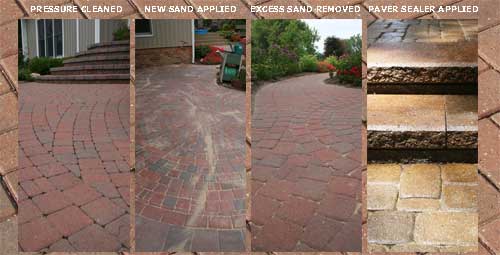553
How to Maintain Brick Pavers in 2025
Benefits of Sealing Your Brick Pavers
Sealing your pavers offers several advantages, including:
- Reduces UV Damage: Protects against fading and discoloration caused by prolonged sun exposure.
- Enhances Color and Appearance: Amplifies the natural beauty of your pavers, with options for matte, semi-gloss, or glossy finishes.
- Adds a Shine (Optional): Choose sealers that create a subtle or bold shine for a polished look.
- Reduces Weeds: Stabilizes joint sand to minimize weed growth.
- Deters Insects: Seals sand joints to prevent pests from nesting.
- Guards Against Stains: Protects against oil spills, rust marks, and other common stains.
- Shields from Salts: Prevents damage from de-icing salts, especially in colder climates.
Maintain Your Pavers Year-Round
- Clean Regularly: Sweep or rinse your pavers to remove debris, dirt, and buildup.
- Inspect for Wear: Look for signs of fading or damage to determine when resealing is necessary.
- Reapply Sealer: Depending on usage and environmental conditions, reseal every 2-3 years to maintain protection and appearance.
By sealing your brick pavers, you’ll preserve their beauty, protect your investment, and enjoy vibrant, durable surfaces for years to come.
How To Seal Brick Pavers
- Clean all brick pavers with a pressure washer. Remove old paver sealer that has failed or discolored with a Paver Sealer Stripper. Use an appropriate Paver Cleaner to remove stains and spills.
- Wait 24-48 hours. Do any needed repairs and leveling of bricks and steps
- Sweep in jointing sand between the paver stones
- Remove excess sand with a leaf blower. It is important that your sand is 1/4″ below the paver edge. You do not want the sand level with the pavers.
- Using your Brick Paver Sealer of choice, apply the sealer following the manufacturer’s directions and spread rate. This can be accomplished with a high-quality pump sprayer or with a roller. If rolling, make sure to be careful of removing the sand from the joints accidentally.
How To Maintain Brick Paver Sealers
Brick Paver Sealers will dull and lose their luster over time but will still “seal” the surface for many years. Using these tips below, you can dramatically extend the life and look of your paver sealer without the need to seal it every year.
- Seal with a High-Quality Solvent Paver Sealer
- Apply a solvent such as Aromatic 100 to restore the sealer’s appearance every 12-18 months. This solvent will reset the current sealer, making it look like it is brand new. The sealer will still be intact, but it can dull from dirt and Ultraviolet radiation. You can do this process 1-2 times before reapplying the sealer is necessary.
- Reapply a Paver Sealer every 2-3 years or as needed
These simple steps will save you the money of sealing too often and the potential issues of overapplication.
Questions? Please Ask Below




What is the best product to seal the sand seam between the brick patio and the house? That area is washing out quicker than the rest.
No sealer can prevent this. The issue is not the sand or the sealer but large gaps or voids in the foundation between the pavers and the house.
Is this available in australia
No, it is not.
30% solid acrylic.
What type of solids are used in the super seal 30.?
Will paver sealants turn opaque in the hot sun. We had sealant put on the overlay of some concrete work we had done and it turned opaque making it look awful! I don’t want this to happen to my pavers.
It depends but most wait a few months.
how soon after brickpavers are laid do you seal them? when is the first time?